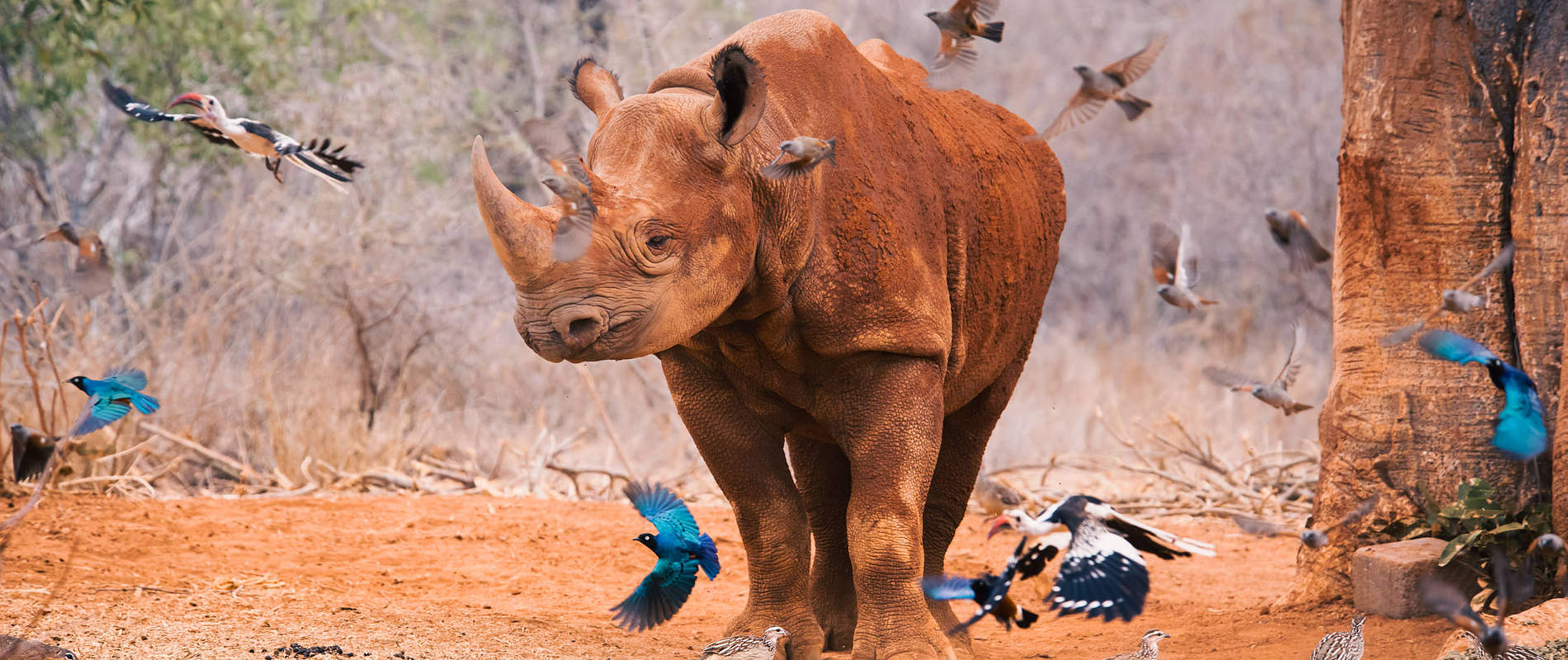Apollo, our no-longer-so-little orphaned black rhino, has spread his proverbial wings and taken an important step in his journey back to the wild.
Four years ago, one of our most gruelling orphan rescues unfolded. During a routine aerial patrol, our pilot received an emergency call from the Kenya Wildlife Service. An infant black rhino had just been spotted in Tsavo West, standing beside his dead mother. (It was later determined that she had died of natural causes.) The calf needed to be rescued before he fled into the bush and possibly disappeared forever.
What ensued was a saga spanning several hours, employing both aerial and ground teams, as we attempted to secure the agile little rhino. Several gallant attempts were made by the fittest rangers to catch the calf, but he torpedoed away each time. With daylight running out, a member of the team pulled off a spectacular tackle, holding onto the rhino's midriff as he was dragged several metres through the bush. Reinforcements converged and together the team managed to finally restrain the young orphan — who, despite being just six months old, packed a serious punch.

Thus began our story with Apollo. For the next four years, he called our Kaluku Neonate Nursery home. Raised by some of our most experienced rhino Keepers, he grew in size, surliness, and stubbornness — all famous traits of his species! Before we knew it, the tiny, squeaking calf who came into our care had blossomed into an impressive young bull.
We have been preparing for Apollo’s next step for many years now. We have created a secure reintegration site at Rhino Base in the heart of Tsavo, specifically with his future in mind. It sits in the middle of the national park, an area that has high oversight and is rigorously patrolled by both ground and aerial teams. With its bush environment, intersected by winding rivers and sandy luggas, Rhino Base is in prime rhino country, where Apollo will be right at home.

Rhino Base was ready and waiting for its new resident — and this year, Apollo made it abundantly clear that he was ready to make the move. In recent months, he has been showing signs of outgrowing Kaluku, becoming increasingly frisky and flighty.
With final plans in place with KWS, we started familiarising Apollo with his moving crate. Surprisingly, he was a model student. Enticed by sugarcane treats, he eagerly walked aboard the crate and became very comfortable in the space.

The move began at first light on the morning of 13th September. Apollo walked into his crate without hesitation. His mind was only on the sugarcane waiting inside! From there, everything unfolded like clockwork. We rigged up the crane truck, which carefully hoisted the crate — with its precious cargo inside — onto the flatbed. Then, Apollo and his entourage made their way to his new home.
Upon arriving at Rhino Base, Dr Limo anaesthetised Apollo so that a radio transmitter could be fitted inside his horn. Then, our boy woke up in his new home. Rhino Base must be Apollo’s idea of paradise: It is a double-sided, open air compound, with one spacious area for sleeping and resting, and another area for mud bathing and playing. We brought masses of his dung over from Kaluku, which we spread around his boma and created middens. Rhinos are very scent-oriented, so this helps Apollo settle in his new territory.

Apollo has a whole team supporting him in his new home, including KWS rangers and some of his favourite Keepers from Kaluku. Justus, who has been with Apollo since the beginning, joined him on the move and will continue to care for him at Rhino Base.
The quieter environment seems to suit Apollo and he is enjoying the relaxed pace of life. While he acclimates to his new home, Apollo is remaining in the large, fenced boma area. The next step is to bring him out into the 50-acre ‘wandering grounds’, which is protected by a lion-proof fence. Once he has settled, he will begin to explore the wider area and the lugga around his base.

Apollo’s reintegration journey is far from over. Re-wilding an orphaned rhino is a slow process — one that cannot be rushed. Over time, he will become known and accepted by the wild rhinos living in Tsavo. Once Apollo has formed his own territory, he will eventually embrace a wild life. This process will unfold gradually over the next several years.
We cannot underscore enough how important individuals like Apollo are. Black rhinos were ruthlessly targeted by poachers in the 1970s and 1980s, reducing their population in Kenya from 20,000 to just 350 in the span of little more than a decade. However, dedicated field conservation efforts and global support have brought populations back from the brink.

While they remain a critically endangered species, Kenya has emerged as a stronghold, home to well over 900 black rhinos. With the population gingerly increasing, every single rhino makes a difference. As Apollo’s individual tale unfolds, he is also part of a much bigger story, one of a species recovering from near-extinction.
Fate robbed Apollo of his mother, but his destiny to be a rhino of Tsavo remains unchanged. We feel very privileged to be a formative part of his life, providing him with the family he deserves, and returning him to his birthright when he is ready.
